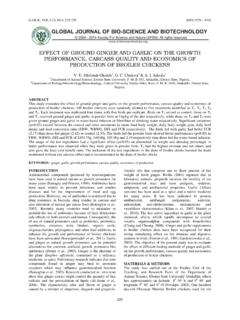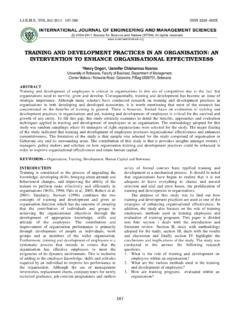Transcription of IDENTIFICATION OF WEEDS IN TURMERIC (CURCUMA LONGA …
1 , (1)2012:121-124 ISSN2229 6441121 IDENTIFICATION OF WEEDS IN TURMERIC (CURCUMA LONGA ) plants using unsupervised skpca algorithm with , , , , ,3,4,5 Department of Electronics and Instrumentation, Bharathiar University, Coimbatore, Tamilnadu, India2 Department of Botany, Bharathiar University, Coimbatore, Tamilnadu, IndiaABSTRACTT urmeric (Curcuma LONGA ) is extensively used as a medicinal plant and food ingredientin India, China and South this paper the implementation of image processing techniques with and Sparse Kernel Principal ComponentAnalysis ( skpca ) is used to identify the WEEDS in between TURMERIC growing out the undesirable plants isone of the major activities related to increasing the agricultural production. Herbicide usage can limit the growth of the impacts of using herbicide causes the major affects in environment and water contamination, this have ledresearcher to find the solutions for their accurate use.
2 A machine vision system for weed IDENTIFICATION , utilized themorphological properties of weed leaves with stem and pixel value of the leaves. Matching of the image features can bedone using unsupervised skpca . The accuracy of using this algorithm is 97%.KEYWORDS: TURMERIC (Curcuma LONGA ), WEEDS , image processing, Machine vision, unsupervised SKPCAINTRODUCTIONIn the present world scenario, India is the world s largestproducer (82%) of TURMERIC (curcuma LONGA ) followed byChina (8%), Myanmar (4%), Nigeria (3%) andBangladesh (3%). Relay 90% of the total productionexhibit allelopathy, ploughing and seed can cause various kinds of losses. In agriculture, WEEDS can reduce plants yield.
3 Stunted plant growth, willcause the decline. Therefore, the farmers control theweeds, to enhance total of fourteen weedspecies belonging to 8 angiosperm families, were recordedin the fields of asperaL.,ChenopodiumalbumL.,Rumex dentatusL., arvensisL.,Cynodon dactylon(L.)Pers.,Oxalis corniculataL.,Malva parvifloraL.,MalvastrumcoromandelianumL. ,Trifolium resupinatumL.,Euphorbia prostartaL. andPhalaris minorRetz, werefound to be the most prevalent weed species occurring in90% or more studied areas during one or the othergrowing WEEDS IDENTIFICATION and then alsodeserves attention for effective control. Botanically, weedsspecies are IDENTIFICATION from whole leaf shape andtexture venation by WEEDS specialists, who visually scoutfields or study high-resolution images of the field research activities in the area of plantidentification have been initiated in recent years.
4 In thefirst investigations, different morphological features wereextracted from digitised images of plants . These featureswere compressed and used for IDENTIFICATION models (Petry& K hbauch, 1989). Others extended such models withknowledge-based rules (Guyeret al., 1993). S kefeldetal.(1996) managed to identify 70% of 22 different weedspecies common in sugar beet by computer vision usingmorphological features and Fourier descriptors. Rath(1997) presented a plant IDENTIFICATION system foridentifying native deciduous trees by their foliage maximum of 93% computer-based IDENTIFICATION ofunknown leaves was paper deals with theapplicability feature matching in image processing usingSKPCA (Sparse Kernel Principle Component Analysis) with unsupervised learning impactsof herbicide usage on the environment have led to manyresearchers orientation toward finding solutions for theiraccurate use.
5 If density and WEEDS species could becorrectly detected, patch spraying or spot spraying caneffectively reduce herbicide usage. A machine vision withprecise automatic weed control system could also reducethe usage of AND METHODFor this study the experimental data of the weed and plantimages were obtained from TURMERIC frequentlyoccurring WEEDS with absolute frequency of above 80%wereC. album L., M. cromandlianum densely populated weed species with higherabsolute density wereA. conyzoides,C. arvensis, dactylon[1]. The studyhighlighted theneed to manage weed in order to realize higher turmericyields. The following figure (1) is the representation of ourproposed studyImage acquisitionA Machine vision system included two cameras in theexperimental system: a front camera for row guidance anda rear camera for in-row detection of individual plants [6].
6 The front camera was tilted forward, facing the directionof travel, to allow a 1 2 m section of the plant row to beviewed enabling the vision system to calculate an accuraterow center line to position the rear camera directly abovethe seed-line. The rear camera was mounted directlybehind the vision-guided toolbar with the lens pointedvertically down toward the plant row to capture a of image capturing area image sizeused was (640x480 dpi with a VGA resolution).PlantIdentification of WEEDS incurcuma longaplants using unsupervised skpca algorithm122rows were traversed in the same serpentine pattern inwhich they were planted. Thus the angle of sunlightchanged from row to row, field to field, and time to camcorder shutter speed was set to 1:500 of a secondto prevent blurred images, but also because outdoor fieldplants may oscillate at high frequencies due to diagram of the proposed studyImage preprocessingTurmeric imagesareacquired from camera in the timeinterval of 48 hours after 20 days of seeding.
7 Separate thebackground from the image by using the colortransformation. An average 50 images were analyzed perday of containing more than 150 TURMERIC plants in and object detectionTo develop a robust machine vision system for outdoorfield conditions, algorithms must be developed to extractuseful information in the presence of noise associated withunstructured lighting conditions. image segmentationis atask of pixel aggregation. After segmentation, each imagepixel is assigned into one of several specific of weed attack distribution is used skpca clustering DEVELOPMENTAn approach where the frame reduction obeys the outputprobability maximization criterion was developed, and it iscalled skpca .
8 It consists in estimating the feature spacesample covariance for a weed component and the sum ofthe weighted outer products of the original feature weights generate the sparse solution for the KPCA,because they represent a measure of how well a specifictraining vector contribute to the likelihood obtained the reduced data, the common KPCA technique is applied and the representationof a feature testvector w is given by Wskpca. Although the skpca generates a reduced training data, it requires the fulloriginal training data to evaluate the maximization step,which could be computationally unfeasible, depending onthe training data amount. In order to solve it, an approachis proposed, where the original training data is clusteredand the skpca is applied to these W is a diagonal matrix composed by the adjustableweights 1.
9 M, and 2is an isotropic noise component,N(0, 2I), common to all dimensions of feature space. Itwas observed that fixing 2, and maximizing thelikelihood under the weighting factors i, the estimates ofseveral iare zero, thus realizing a reduced (sparse)representation of thecovariance matrix. This approachwas based on the probabilistic PCA (PPCA) formulation[5]. Further simplification of this formula is made by there-estimation of the feature weights and skpca of thediagonal matrix can be obtained [6].where Kand Kare defined, respectively, as theeigenvectors and Eigen values of W1/2KW1/2and kwrepresents the vector calculated by k(w, xi), where xicorresponds to the non-zero weighted vectors representedin the figure 3, the feature matching of the weedsand the plants are done using their features.
10 The limits-1to 0 indicates the WEEDS and 0 to 1 indicates the approach of the skpca withUnsupervised proposed approach consists in making theSKPCA technique computationally feasible for a dataset with a great number of samples; the skpca re-estimation is computationally unfeasible, once itdepends on the kernel matrix K to calculate . algorithm for training databaseK-means clustering is proposed to divide the full trainingdata into unsupervised clusters algorithm of L frames, andthen merge the clusters forming new clusters of 2L frames,which are reduced to L frames by using skpca . Theprocess is repeated successively until obtaining justonecluster of L frames, which is the final number of framesdesired to represent the full training data.









